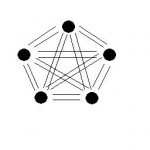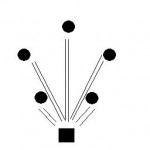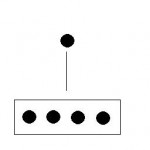Effective Communication
Communication is vital in project management. In fact, I’d say good communication skills are one of the most important qualities a project manager can possess. But is a project manager getting involved in the internal communication of the project team actually providing value?
As a quick thought experiment, let’s imagine a team of five members. In a self-organising team, it may be that each member has a discussion with every other member to let them know where they are up to, what they are working on, etc. This communication, in one direction (i.e. person A telling person B their situation) takes an amount of time I’ll call t.
 Now, the communication cannot be one way – person B also needs to tell person A what they are up to. So they also take time t to pass that information on. So the total time for the update conversation is 2t. But the total work time is 4t – i.e. 2t for each participant.
Now, the communication cannot be one way – person B also needs to tell person A what they are up to. So they also take time t to pass that information on. So the total time for the update conversation is 2t. But the total work time is 4t – i.e. 2t for each participant.
I have shown this situation in the 5 person team in the diagram. In this situation, each person talks to every other person. There are 10 conversations, each taking a time of 2t. This means, with two people in each conversation, the total work time used is 40t.
 Now let’s look at the situation when we add a project manager. In this case, I have assumed each team member tells the project manager where they are up to. The project manager then evaluates the information, and feeds back to every team member. The two way conversation thus still exists, though the two ways may happen at different times. In this model, there are 5 conversations, each of which take time 2t, giving a total time of 10t, or a total work time of 20t.
Now let’s look at the situation when we add a project manager. In this case, I have assumed each team member tells the project manager where they are up to. The project manager then evaluates the information, and feeds back to every team member. The two way conversation thus still exists, though the two ways may happen at different times. In this model, there are 5 conversations, each of which take time 2t, giving a total time of 10t, or a total work time of 20t.
In other words, adding a project manager reduces the time the team spends in sharing information by half – in this particular case.
 Of course, there are other possibilities. It may be the self-organising team shares information through a meeting, rather than separate conversations. This would dramatically reduce the total time. In this model, person A tells all the other members of the team what they are doing at the same time. Then person B does so, and so on.
Of course, there are other possibilities. It may be the self-organising team shares information through a meeting, rather than separate conversations. This would dramatically reduce the total time. In this model, person A tells all the other members of the team what they are doing at the same time. Then person B does so, and so on.
This reduces the total time taken to just 5t, but the total work time is only reduced to 25t – it only takes person A time t to update the other 4, but each of the 5 has to be there, a total of 5t work time. This is repeated for the other 4 people.
In a team with a manager the total work time would be higher – purely because the project manager has to sit in the meeting too. If, however, the project manager receives updates from the team members individually (for a total work time of 10t) and then feeds back to the entire team (for a total work time of 6t) then we have a total work time of 16t – again less than in the self-organising team.
We can easily expand this up to teams with 10 members. In this case, team members holding individual conversations gives us a total work time used in communication of 180t, a team holding a meeting gives a total work time of 100t, while a team using a manager and meetings takes a total work time of 31t!
At this point it all looks cut and dried – self-organising teams, even if they use meetings, spend far more time in communication than a managed team.
Of course, that’s only true when you have been as grossly unfair with the figures as I have. (Using pseudo-scientific methods and information to draw unfounded conclusions is fun!)
The most obvious way I have been unfair is assuming the project manager can condense down everything all the team members need to know massively. In the model where the manager has a conversation with each team member, I have decided the information which the other team members took 4t to pass to him can somehow be condensed down to only take t for him to pass on! This seems rather unlikely…
So no, I’m not saying these figures are going to be accurate. But they do illustrate some important ideas.
- Time taken to communicate amongst a team rises dramatically with team size.
- The most effective way to reduce this is to hold meetings, so team members don’t have to repeat themselves with each other member.
- Project managers can aid communication if they act as a central collation point.
- But the best improvement in communication comes if the project manager condenses or filters the information.
In other words, you need to be more than good at talking. A project manager needs to understand the project well enough to know who needs to know which pieces of information, and just as importantly, which pieces of information are of no use to other members. You need to act as a filter, to make sure you’re not wasting the time of your team members.
Communication isn’t about how much you say to everyone, it’s about saying the right things to the right people.
Hi Trevor
A fun use of pseudo science that does illustrate the importance of communications in project management.
I do believe that project communications is more than just within the team – that’s the easy bit as the team share common goals and passions.
The harder bit is using communications to persuade end users – those whose working lives will be changed by the project – that this change is good for them, their customers and their colleagues.
Project teams also need to spend a good chunk of time communicating with senior executives to maintain their active support.
Then once you’ve delivered successfully you need to tell people how well you’ve done.
Communicating projects is all about active listening, creating desire for change, minimising resistance, changing perceptions.
Regards, Jo Ann
http://www.sweeneycomms.com
In my opinion, this is a good starting point. The next step would be thinking about how to use this concept for maintaining proficient relationships with the (other) stakeholders.
This can be achieved controlling the quality of information.
The parameters for validating the information are:
Reliability. It uses metrics that allows checking the validity of the data.
Efficiency. Usage of figures showing the output (e.g.
EVM).Acceptability. PM has to find a common ground with the stakeholders outside the team. It means going deeper than a simple usage of the correct language.
… (more at)
In my opinion, this is a good starting point. The next step would be thinking about how to use this concept for maintaining proficient relationships with the (other) stakeholders. This can be achieved controlling the quality of information.
The parameters for validating the information are:
Reliability. It uses metrics that allows checking the validity of the data.
Efficiency. Usage of figures showing the output (e.g.EVM).
Acceptability. PM has to find a common ground with the stakeholders outside the team. It means going deeper than a simple usage of the correct language.
…
[…] Effective Communication | Project Management Guide […]
[…] we need to be comfortable communicating when we are managing a project. Clearly, we need to enable effective communication within the project, so that team members and others have the information they need about what […]
[…] before about my general dislike for meetings, but they do have value as well. They are a very effective means of communication, so long as we make the best use of them that we […]
[…] For more information on effective communication in relation to project management, visit: http://www.projectmanagementguide.org/project-management/effective-communication […]
[…] In addition to the scope, this past week focused on developing the key components of a communication plan. An effective communications plan needs to include what will be communicated to the stakeholders, how it will be communicated, and how often it will be communicated (Bowen, 2013). Within the communications plan, the project manager should include such information as the stakeholders analysis, the objectives of the project, the schedule and frequency of meetings, the responsibilities of the team members, potential risks of the project, and the project’s budget (Charvat, 2002; Bowen, 2013). According to Bowen (2013), an effective communication plan “ensures that all stakeholders are equally informed of how, when, and why the communication will happen”. Visually, the project manager should consider the page layout and design, as well as the fonts and colors of the document itself (Bourne, 2011). The plan itself should also be simple and well organized (Cox, 2009). Click here for the math behind an effective communication plan. […]
Hello blogger i see you don’t monetize your blog.
You can earn extra bucks easily, search on youtube for: how to
earn selling articles
Thank you for some other great article. The place else
could anybody get that type of information in such a perfect
method of writing? I’ve a presentation next week, and I am at the look for such
information.
Good day :)
What an fantastic blog!
May I scrape it and share it with my website subscribers?
My site is about Korean 한국야동
If ever you are interested, feel free to visit my channel and check it out.
Thanks and Keep up the good work!
Dit is erg interessant, Ubent een zeer blogger.
Ik heb me aangemeld voor uw feed en kijk ernar uit om meer van uw uitstekende berichten te lezen. Daaraast heb ik
uw website gedeeld op mijn sociale netwerken!